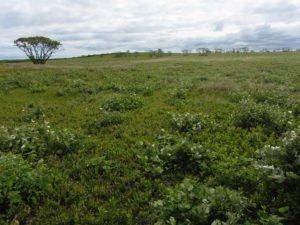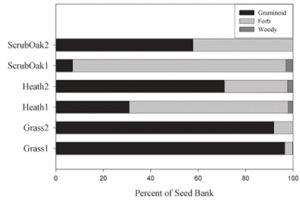Conversion from Forest or Shrubland at Middle Moors
The Middle Moors is the largest undeveloped open space on Nantucket and totals more than 4,000 acres (1,620 hectares) of protected lands (Fig. 1). The majority of this area is owned and managed by the Nantucket Conservation Foundation (NCF), including the portion that is commonly called Nantucket’s “Serengeti.” This area contains more than 400 acres (162 hectares) of a savanna-like habitat that contains mostly shrubland, patches of grassland and occasional trees. The Serengeti is located in the center of the island on morainal soils, more inland than other open-land habitats. Historically, this area had large expanses of open grasslands created by sheep grazing during the 1700 and 1800s. Between the cessation of grazing and the advent of mowing management in 1998, the vegetation cover was described as “closed shrub oak” with greater than 75 percent cover of scrub oak (Quercus illicifolia).
The Middle Moors consists of a mosaic of shrubland, heathland and grassland, but predominately shrubland. Omand et al. (2014) described this habitat as a monoculture of scrub oak shrubland dominated by scrub oak and dwarf chinquapin oak (Quercus prinoides) 3-6 m tall. This habitat-type is less diverse than heathland and grassland.
Management Goals
- Reduce woody cover to create sandplain grassland;
- Disturb soil to increase the removal of scrub oak by breaking up scrub oak roots and soil, removing woody debris on the ground, and exposing mineral soil to encourage the germination of seeds of native warm season grasses and forbs;
- Plant a mix of native seeds to establish sandplain grassland.
Management History
The NCF’s management goal in the Serengeti was to restore the areas of grasslands and heathlands that existed about a century ago. Historically sheep grazing reduced taller shrubs and promoted grasses and forbs. But grazing was removed completely from this area by late 1800s and scrub oak and pitch pine (Pinus rigida) grew back rapidly.
Nantucket Golf Club provided the initial funding for restoration and maintenance of open habitat in the Middle Moors on property owned by NCF and Mass Audubon. Follow-up management is now the responsibility of these current property owners. Restoration methods including brush cutting and prescribed burning to reduce cover of scrub oak and other tree species. Begun in 1998, annual dormant season mowing (with some summer mowing at the initiation of the project) has been the primary management technique utilized in the Serengeti. Mowing was selected because of the challenges of burning large expanses of scrub oak. Annual mowing reduced the height of scrub oak, but not much establishment of grass species was observed. Scrub oak resprouted quickly after cutting and mowing over time was repeated to attempt to keep up with the rapid scrub oak regrowth.
Experimental disc harrowing of the soil was implemented in a small area of the Serengeti to test effects of more complete scrub oak removal. The goal of harrowing was to increase the removal of scrub oak by breaking up roots and soil, removing woody debris on the ground, and exposing mineral soil, which supports the germination of grass and forbs. Initially just harrowing was tested, and then harrowing and combined seeding of native grasses was tested.
Seed Bank Composition in Early Successional Communities
Based on the results of the initial Harrowing Project research, Omand et al. (2014) completed a seedbank study that compared seedbanks in grasslands, heathlands, and scrub oak shrublands on Nantucket, including the Middle Moors. This study was done to determine the potential need for seed addition during restoration projects in these areas. Soil samples collected in September 2007 were cold stratified and planted in a greenhouse where seedling emergence was recorded and seedlings were identified weekly from April 1 until September 30, 2008 (germination of new seedlings slowed after six months).
The frequency of grass seedling germination was much lower in the Middle Moors sample than in other locations (Fig. 3). The shrubland Middle Moors seedbank contained predominantly woody species and weedy species such as horseweed (Erigeron canadensis). The diversity of native forbs and grasses contained in the seedbank of the grasslands was not present in the shrublands. The limited diversity of grasses and forbs in the scrub oak shrublands indicates that seeding with native seeds may be very important for conversion from forest and shrubland to sandplain grasslands. Omand et al. (2014) suggested: (1) further study of the effect of duff and mineral substrates on the post-seeding germination of important grassland species, and (2) tests of the effects of duff removal or mixing of soil layers (i.e., by harrowing) when combined with native seed addition.
Large Scale Harrowing and Native Seed Addition
The results of the initial Harrowing Project and the Seedbank research indicated that small-scale soil disturbance led to a short-term increase in grass and forbs but a quick return to woody species dominance and that the soil seedbank in these scrub oak-dominated areas lacked key native grassland species. In 2011, the NCF initiated a final experiment to examine larger-scale soil disturbance (disc harrowing) combined with seed addition of native species to effectively reduce woody cover and increase grassland habitat.
One unit of 3.1 acres (1.25 hectares) was treated with disk harrowing in late autumn of 2010; the second unit of 2.9 acres (1.16 hectares) was left undisturbed with the exception of continued annual brush-cutting. Thirty 1.0 m2 plots of each treatment (Harrow, Harrow & Seed, Control and Seed Only) were located randomly and monitored pre-treatment and annually for three years post-treatment for vegetation percent cover by growth form (woody, forb, and graminoid), species composition, and substrate type. In addition, permanent photomonitoring points were established along the perimeter of the study site and visited each year to visually document change over time.
Large-scale soil disturbance from disc harrowing effectively reduced woody cover, particularly of aggressive native species such as scrub oak and black huckleberry. Rebounds in woody species cover in the third year of monitoring within Harrowed and Harrowed & Seeded plots were primarily caused by vigorous regrowth of bristly dewberry (Rubus hispidus), a low-growing and desirable component of grasslands and heathlands. Scrub oak, black huckleberry and low-bush blueberry had very little cover three years post-harrowing. Harrowing alone boosted both graminoid and forb cover, but the harrowed plots lacked little bluestem grass (Schizachyriuim scroparium) and other key grassland and heathland species. Harrowing strongly decreased the aggressive clonal native graminoid Pennsylvania sedge (Carex pensylvanica) and combined harrowing and seed addition further slowed recolonization by this species, presumably due to the rapid establishment of sown little bluestem grass. Combined harrowing and seeding also shifted the vegetation composition more strongly toward that of grassland than harrowing alone, mainly by establishing the key little bluestem grass grassland dominant species. However, the rapid germination and expansion of little bluestem grass appeared to limit the success of other sown species as well as those emerging from the seedbank. The composition of plots without soil disturbance, with or without seed addition, remained nearly the same.
Conclusions and Management Implications
Ultimately, annual mowing alone reduces shrub height but does not eliminate shrub cover or increase grasses and forb dominance within scrub oak dominated shrublands. Harrowing or other large-scale soil disturbance can help promote conversion to early successional grassland by breaking up shrub roots and removing duff to exposing mineral soil for seed germination. Shrubland seedbanks contain a smaller component of grass and forb seeds than do grasslands, so seeding with native grasses and forbs after harrowing is important for increasing grassland plant diversity after initial mowing of scrub oak. Combining soil disturbance and native seed addition in scrub oak dominated shrublands appears to be a valuable tool for expanding grassland habitat.
Large Scale Harrowing and Native Seed Addition
The results of the initial Harrowing project and the Seed Bank research indicated that small scale soil disturbance leads to a short-term increase in grass and forbs but a quick return to woody species dominance and that the soil seed bank in these Q. ilicifolia dominated areas lack key native grassland species. In 2011, the Foundation initiated a final experiment to examine larger-scale soil disturbance (disc harrowing) combined with seed addition of native species to effectively reduce woody cover and increase grassland habitat.
One unit (1.25 hectares) was treated with disk harrowing in late autumn of 2010; the second unit (1.16 hectares) was left undisturbed with the exception of continued annual brush-cutting. Thirty 1m2 plot locations per treatment (Harrow, Harrow & Seed, Control and Seed Only) were randomly located and monitored pre-treatment and annually for 3 years post-treatment for vegetation percent cover by growth form (woody, forb, and graminoid), species and substrate type. Additionally, permanent photomonitoring points were established along the perimeter of the study site and visited each year to visually document change over time.
Large-scale soil disturbance from disc harrowing effectively reduced woody cover, particularly of aggressive native species such as scrub oak and black huckleberry. Rebounds in woody species cover in the third year of monitoring within Harrowed and Harrowed & Seeded plots were primarily due to vigorous regrowth of bristly dewberry (Rubus hispidus), a low-growing desirable component of grasslands and heathlands. Scrub oak, black huckleberry and low-bush blueberry had very little cover three years post-harrowing. Harrowing alone was effective in boosting both graminoid and forb cover, but the harrowed plots lacked little bluestem and other key grassland and heathland species. Harrowing strongly impacted the aggressive clonal native graminoid Pennsylvania sedge (Carex pensylvanica); combined harrowing and seed addition further slowed recolonization by this species, presumably due to the rapid establishment of sown little bluestem. Combined harrowing and seeding also shifted the vegetation composition more strongly toward that of grassland than harrowing alone, mainly by establishing the key grassland dominant, little bluestem. However, the rapid germination and expansion of little bluestem appeared to limit the success of other sown species as well as those emerging from the seed bank. The composition of plots without soil disturbance, with or without seed addition, remained nearly the same.
Conclusions and Management Implications
Ultimately, annual mowing alone reduces shrub height but does not eliminate shrub cover or increase grasses and forb dominance within scrub oak dominated shrublands. Harrowing or other large-scale soil disturbance can help promote conversion to early successional grassland by breaking up shrub roots and removing duff to expose mineral soil for seed germination. Shrubland seedbanks contain a smaller component of grass and forb seeds than do grasslands, so seeding with native grasses and forbs after harrowing is important for increasing grassland plant diversity after initial mowing of scrub oak. Combining soil disturbance and native seed addition in scrub oak dominated shrublands appears to be a valuable tool for expanding grassland habitat.
Omand, K.A., Karberg, J.M., Beattie, K.C., O’Dell, D.I., & Freeman, R.S. 2014. Soil seedbank in Nantucket’s early successional communities: implications for management. Natural Areas Journal 34: 188–199.
Other Sources
Beattie, Karen. Interviewed by Lena Champlin. Unknown date.
Steinauer, Ernie. Interviewed by Lena Champlin. December 5, 2016.



